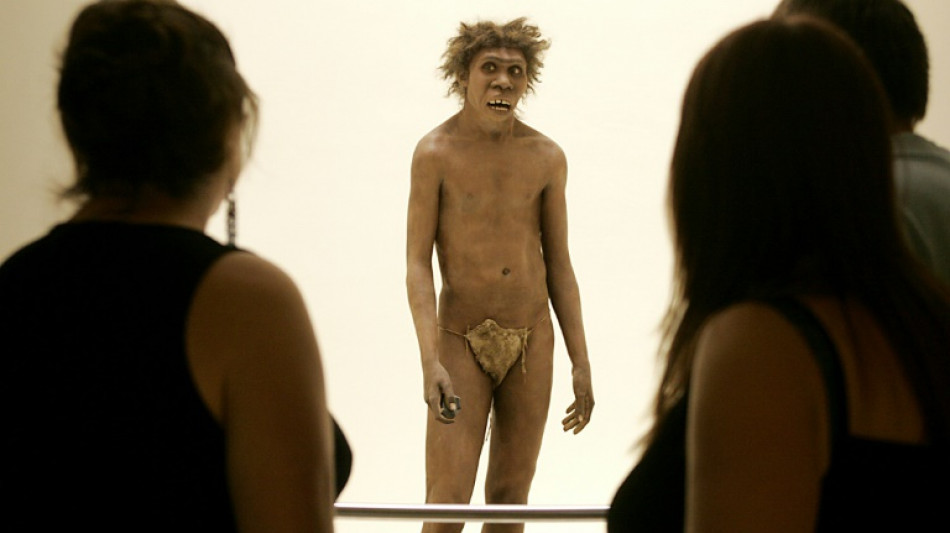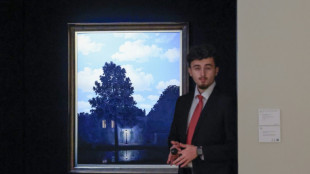
-
 Russian opposition marches against Putin in Berlin
Russian opposition marches against Putin in Berlin
-
Ukraine announces power restrictions after 'massive' Russian attack

-
 Biden begins historic Amazon trip amid Trump climate fears
Biden begins historic Amazon trip amid Trump climate fears
-
Dozens killed, missing in Israeli strike on devastated north Gaza

-
 Macron defends French farmers in talks with Argentina's Milei
Macron defends French farmers in talks with Argentina's Milei
-
England players to blame for losing streak says captain George

-
 'Emotional' Martin defies Bagnaia to claim first MotoGP world championship
'Emotional' Martin defies Bagnaia to claim first MotoGP world championship
-
Slovakia beat Australia to reach BJK Cup semi-finals

-
 Sluggish Italy fight to narrow win over Georgia
Sluggish Italy fight to narrow win over Georgia
-
India and Nigeria renew ties as Modi visits

-
 Grit and talent, a promise and a dilemma: three things about Jorge Martin
Grit and talent, a promise and a dilemma: three things about Jorge Martin
-
Martin denies Bagnaia to win first MotoGP world championship

-
 Typhoon Man-yi weakens as it crosses Philippines' main island
Typhoon Man-yi weakens as it crosses Philippines' main island
-
Noel wins season-opening slalom in Levi as Hirscher struggles

-
 Tough questions for England as Springboks make it five defeats in a row
Tough questions for England as Springboks make it five defeats in a row
-
Russia pounds Ukraine with 'massive' attack in 'hellish' night

-
 McIlroy clinches Race to Dubai title with DP World Tour Championship win
McIlroy clinches Race to Dubai title with DP World Tour Championship win
-
Glastonbury 2025 tickets sell out in 35 minutes

-
 迪拜棕榈岛索菲特美憬阁酒店: 五星級健康綠洲
迪拜棕榈岛索菲特美憬阁酒店: 五星級健康綠洲
-
The Retreat Palm Dubai MGallery by Sofitel: Пятизвездочный велнес-оазис

-
 New Zealand win revives France on their road to 2027 World Cup
New Zealand win revives France on their road to 2027 World Cup
-
The Retreat Palm Dubai MGallery by Sofitel: A five-star wellness Oasis

-
 Israel hits Gaza and Lebanon in deadly strikes
Israel hits Gaza and Lebanon in deadly strikes
-
Power cuts as Russian missiles pound Ukraine's energy grid

-
 Denmark's Victoria Kjaer Theilvig crowned Miss Universe 2024
Denmark's Victoria Kjaer Theilvig crowned Miss Universe 2024
-
Dutch police use hologram to try and decode sex worker's murder

-
 Israel bombs south Beirut after Hezbollah targets Haifa area
Israel bombs south Beirut after Hezbollah targets Haifa area
-
Biden in historic Amazon trip as Trump return sparks climate fears

-
 India hails 'historic' hypersonic missile test flight
India hails 'historic' hypersonic missile test flight
-
Israel orders Beirut residents to flee after Hezbollah targets Haifa area

-
 Davis, LeBron power Lakers over Pelicans as Celtics win in OT
Davis, LeBron power Lakers over Pelicans as Celtics win in OT
-
Trump and allies return to New York for UFC fights

-
 Hong Kong political freedoms in spotlight during bumper trial week
Hong Kong political freedoms in spotlight during bumper trial week
-
Debt-saddled Laos struggles to tame rampant inflation

-
 Senna, Schumacher... Beganovic? Macau GP showcases future F1 stars
Senna, Schumacher... Beganovic? Macau GP showcases future F1 stars
-
India's vinyl revival finds its groove

-
 G20 tests Brazil's clout in Lula 3.0 era
G20 tests Brazil's clout in Lula 3.0 era
-
Over 20,000 displaced by gang violence in Haiti: UN agency

-
 Famed gymastics coach Bela Karolyi dies
Famed gymastics coach Bela Karolyi dies
-
'Break taboos': Josep Borrell wraps up time as EU's top diplomat

-
 Climate finance can be hard sell, says aide to banks and PMs
Climate finance can be hard sell, says aide to banks and PMs
-
Trump revives 'peace through strength,' but meaning up to debate

-
 New York auction records expected for a Magritte... and a banana
New York auction records expected for a Magritte... and a banana
-
Egypt's middle class cuts costs as IMF-backed reforms take hold

-
 Beirut businesses struggle to stay afloat under Israeli raids
Beirut businesses struggle to stay afloat under Israeli raids
-
Dupont lauds France 'pragmatism' in tight New Zealand win

-
 Swiatek leads Poland into maiden BJK Cup semi-final
Swiatek leads Poland into maiden BJK Cup semi-final
-
Trump taps fracking magnate and climate skeptic as energy chief

-
 West Indies restore pride with high-scoring win over England
West Indies restore pride with high-scoring win over England
-
Hull clings to one-shot lead over Korda, Zhang at LPGA Annika


First 'concrete picture' of Neanderthal family revealed by DNA
The original Flintstones? The largest genetic study of Neanderthals ever conducted has offered an unprecedented snapshot of a family, including a father and his teenage daughter, who lived in a Siberian cave around 54,000 years ago.
The new research, published in the journal Nature on Wednesday, used DNA sequencing to look at the social life of a Neanderthal community, finding that women were more likely to stray from the cave than men.
Previous archaeological excavations have shown that Neanderthals were more sophisticated than once thought, burying their dead and making elaborate tools and ornaments.
However little is known about their family structure or how their society was organised.
The sequencing of the first Neanderthal genome in 2010, which won Swedish paleogeneticist Svante Paabo the medicine Nobel prize earlier this month, offered a new way to discover more about our long extinct forerunners.
An international team of researchers focused on multiple Neanderthal remains found in the Chagyrskaya and Okladnikov caves in southern Siberia.
The scattered fragments of bones were mostly in a single layer in the earth, suggesting the Neanderthals lived around the same time.
"First we had to identify how many individuals we had," Stephane Peyregne, an evolutionary geneticist at Germany's Max Planck Institute and one of the study's co-authors, told AFP.
- 'Seem much more human' -
The team used new techniques to extract and isolate the ancient DNA from the remains.
By sequencing the DNA, they established there were 13 Neanderthals, seven males and six females. Five of the group were children or early adolescents.
Eleven were from the Chagyrskaya cave, many of them from the same family including the father and his teenage daughter, as well as a young boy and a woman who were second-degree relatives, such as a cousin, aunt or grandmother.
The researchers also worked out that one man was a maternal relative of the father because he had a genetic phenomenon called heteroplasmy, which only passes down a couple of generations.
"Our study provides a concrete picture of what a Neandertal community may have looked like," Max Planck's Benjamin Peter, who supervised the research along with Paabo, said in a statement.
"It makes Neandertals seem much more human to me," he added.
Genetic analysis showed that the group did not interbreed with its nearby relatives such as humans and Denisovans, hominins discovered by Paabo in caves just a few hundred kilometres away.
However we know that Neanderthals did breed with homo sapiens at some point -- Paabo's research also revealed that almost all modern humans have a little Neanderthal DNA.
- Rampant inbreeding -
The community of around 10 to 20 Neanderthals seems to have instead bred largely among themselves, displaying very little genetic diversity, the study found.
Neanderthals existed between 430,000 to 40,000 years ago, so this group was living in the twilight of its species.
The study compared the community's level of inbreeding to endangered mountain gorillas. Another explanation for the inbreeding could be that the Neanderthals lived in an isolated region.
"We are probably dealing with a very subdivided population," Peyregne said.
The researchers found that the group's Y-chromosomes, which are inherited from father to son, were far less diverse than its mitochondrial DNA, which is inherited from mothers.
This suggests that the women travelled more frequently to interact and breed with different groups of Neanderthals, while the men largely stayed home.
Antoine Balzeau, a palaeoanthropologist at France's National Museum of Natural History, said that fossils found in the Sidron Cave in Spain prompted suggestions of a similar Neanderthal community there, but far less complete genetic material is available.
Balzeau, who was not involved in the latest study, said it was "a very interesting technical feat".
But "it will have to be compared with other groups" of Neanderthals, he added.
H.Romero--AT

